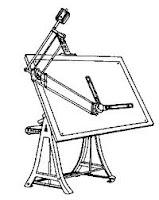
An open window’s unique view
Thrusts awareness upon you
Look up, look down, look left, look right
Inspiration lies in plain sight
Make note of what you see
There’s magic in imagery
Spirits of inspiration
Whisper through imagination
~Sharla Lee Shults
Each of us approaches writing from different viewpoints but each writer brings to the writing board knowledge, experience, and awareness or perhaps a blending, which has been known to result in a mishmash of random thoughts.
Sometimes ideas expand life’s very existence and soar on the wings of imagination. Such mental flights lead to destinations beyond reality into a realm of wonder.
But, what inspires the mind to enter into this imaginative domain: Is it fact bound by secretive desires or vessels bearing messages of sheer fantasy? Is it simply a matter of fact or fantasy, or could both be carriers of this infectious passion to imagine?
Take the architect for example: the designer behind that which puts inspired visions and the very essence of imagination to their ultimate test. What are his tools? Is his drawing board really much different from a writer’s writing board? Doesn’t architectural design require going beyond the limits into depths sometimes totally unfathomable?

An Architect's Drawing Board
Like the writer, the architect must begin with ideas utilizing knowledge, awareness and experience. Throughout the planning phase, random thoughts may shift the facts opening windows toward dreams, a fantasy ultimately becoming reality.
Some basic architectural tools necessary in producing the blueprint, or design plan, include the drawing board, compass and triangle. Let’s examine how each perhaps has its own place on the writing board and what each one has to offer as inspiration.
Drawing board – The Soul
 Guileless, mind-boggling, gut-wrenching, heart-warming, such descriptors shape the whole and parts that comprise the soul or platform for either design attempts or writing. But, here again, where does the inspiration lie?
Guileless, mind-boggling, gut-wrenching, heart-warming, such descriptors shape the whole and parts that comprise the soul or platform for either design attempts or writing. But, here again, where does the inspiration lie?
If the goal is simplicity, perhaps knowledge alone is enough to inspire documentation supported by discovery and research. Life, however, is a journey during which a vast amount of knowledge is accumulated along the way.
Real-life experiences fill in the gaps thereby creating uniqueness. It is within such experiences where inspiration is gathered and shared.
Most important, however, is awareness: being able to observe and listen to life’s quiet whisperings. Think about it: A person can be blessed with a plethora of knowledge along with multiple experiences to his credit yet be totally deft to the whispers of awareness.
The architect’s drawing board is the soul for the writer. This is where the written word presents itself in forms that reach the deepest depths of the gut or adds flair and flavor to warm the coldest heart. It is here that the spirit reflects light or darkness, seriousness or humor, individuality or family, peacetime or war, beauty or beastliness, or perhaps faith, charity and love.
This is where imagination meets creativity: awareness is intense, inspiration is born.
Triangle – The Heart
 Whether creative non-fiction, fiction or poetry, all three propagate from emotion echoing directly from the heart. Encounters in life lead to different forms of writing for different purposes—fascination, relaxation or inspiration.
Whether creative non-fiction, fiction or poetry, all three propagate from emotion echoing directly from the heart. Encounters in life lead to different forms of writing for different purposes—fascination, relaxation or inspiration.
Fascination feeds the imagination and breeds fantasy. Relaxation of the mind stills the heart. Uplifting words reflect on individual or family occurrences, camaraderie and adversity, love, hope, and reality, as well as dreams and fantasies.
Words of wisdom often present themselves as encouragement throughout the day or through an eventful time in life allowing emotions to escalate or simmer.
For the architect, the triangle is used for precision and venturing outside the circle much like the writer who thinks outside the box. Triangulation occurs within the writer’s heart as emotions vacillate from frustration, anger and despair to love, passion and fear while confronting possible shadows of loneliness, shame and rejection.
Within a moment’s time, feelings of joy, isolation and being downright scared exist as the heart maintains rhythm, color and style!
Remember, life is a journey; let its destination be where the heart wants to be. Don’t listen to voices of doubt and dissent; inspiration takes control when you listen to your heart.
Compass – The Mind
 The mind constantly changes direction and writing can sometimes present itself in full circle bringing you back to where you started – a 360° turn – with feelings of ‘spinning your wheels’ so to speak.
The mind constantly changes direction and writing can sometimes present itself in full circle bringing you back to where you started – a 360° turn – with feelings of ‘spinning your wheels’ so to speak.
The ideas are there but the connection has not been made as the mind randomly shifts from one thought to another. Yet, don’t let go completely of any random thought for it may be the seed from which new inspiration grows.
This is the place where sectors present themselves in varying degrees. Where the compass bisects angles and produces arcs of different degree measures for the architect, so do the words, ideas, expressions and thoughts of the writer present varying degrees of interpretation and perception as they pass through the corridors of the mind. They slip and slide, are cut and replaced, bound together and segmented, overturned and overlooked until the pieces fit together and flow smoothly from beginning to end.
Without the mind’s compass to cross the divides and frame the intersections, the blueprint would be imaginative but fail to meet the challenge of inspiration. Sometimes it is best to just stop. Walk away. Step outside and listen to life’s songs. A quiet mind echoes inspiration of the heart and soul.
The Blueprint – The Body
 Full throttle ahead . . . the platform is set, emotions are in place, the mind is focused!
Full throttle ahead . . . the platform is set, emotions are in place, the mind is focused!
While the compass and triangle bring life to the architect’s drawing board, the heart, mind and soul transport thoughts, feelings and desires to the writing board. The embodiment of all things imagined is heightened through inspiration and awareness acquired along life’s journey.
So, how does imagination become the blueprint for writing?
It comes from conscious awareness of all that is around you. It is the scariest of the scariest, the loveliest of the loveliest, the good with the bad, the happy and the sad. It is inspiration received from observing life at its best (or worst), listening to life’s songs, embracing life’s bounties, breathing the breath of life and above all savoring life to its fullest.
It’s looking upward watching white puffs of cotton become shades of pink cotton candy then, quickly transforming into deep shades of gray waiting to quench the thirst of all willing to savor and cherish every drop.
It is the Atala butterflies hovering in the wind radiating incandescent blue-green on their wings as red-orange abdomens expand in the sun. It is the angel of light appearing through the mist casting sunbeams that overcome the shadows. It is the ladybird feeding on the whitefly and aphids revealing beneath its wings a moment captured.
What inspires your blueprint for writing? Just imagine.
Think about the architect: Where do suppose he got the inspiration to build a house whose windows offer a 360° view from the ocean to mountains to a valley toward sunset and a sky flooded with city lights? What inspired a seamless expanse of glass? Could it be the influence of an intimate connection with nature?
Inspiration is nature viewed as a diamond in the rough. Take a break for whatever is going on in your life. Step outside. Look around. Each day try and notice something you did not see, hear or smell the day before. Captivating moments are right before your eyes, music to your ears, within your very grasp and under your nose waiting to be enjoyed. Walk among the wildflowers and take time to smell the rain!
About the Author
Sharla Lee Shults is a motivational and inspirational speaker and writer. She writes on her personal blog Catnipoflife, 2012. Make sure you check out some more of her awesome articles.
Bookmark, Share and Print
Please share it if you think it would help others too.

